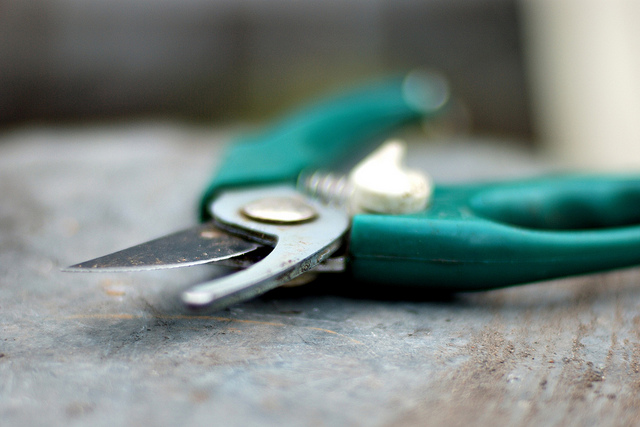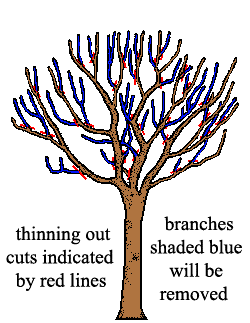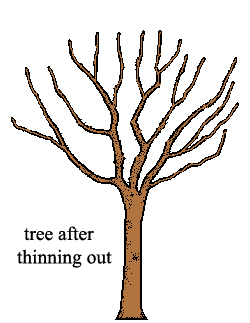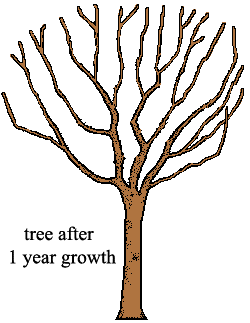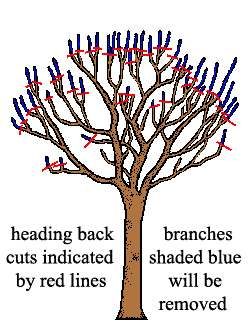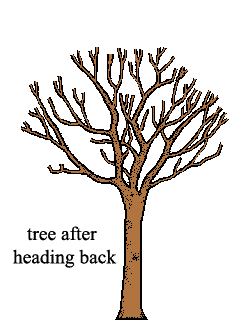Pruning is intimidating enough that many of us avoid it altogether. Knowing a few basics can help to avoid common pitfalls and you’ll be well on your way to successfully improving the appearance and health of your plants.
We prune for several reasons: for plant health, better shape or size, or better flower or fruit production. Here are three pruning rules to follow:
Prune out dead, diseased, and damaged branches
Prune out crossing branches, rubbing branches, and "suckers" (shoots that grow very fast and straight)
Prune for shape
While we’re keeping those rules in mind, we'll discuss two pruning methods and their effects on subsequent growth. We will also take a look at useful tools, how to make pruning cuts, and when to prune.
PRUNING TOOLS
Proper tools can make pruning jobs so much less of a hassle. Consider the following:
Needlenose Pruners
Pruning Shears
Loppers
Pruning Saw
Needlenose pruners: These scissor-like shears make tight, close cuts on plants. They're great for use on thin stems and tight spots.
Pruning shears: For use on branches up to about 3/4 inch in diameter, these hand pruners can trim tougher stems and branches with a clean cut.
Loppers: Reach for the lopping shears for thicker branches up to about 1 1/2 inches in diameter, or for branches that take too much grip strength to cut with pruning shears.
Pruning saw: You can use a pruning saw for branches that are more than about 1 1/2 inches in diameter, or for branches too large and difficult for hand pruners or loppers.
For all pruning tools, keeping the blades sharp will make cleaner cuts and make your job easier.
If plants show signs of disease, spreading pathogens between them is a significant concern. Practice good sanitation by cleaning shears between cuts on diseased plants and between pruning different plants using Lysol or rubbing alcohol (bleach is very corrosive). Throw away diseased plant material and do NOT put this diseased material into your home compost or back into your garden. Some diseases can live in soil for years, so it's important to keep them away from your garden!
Types of Pruning Cuts
Thinning
Thinning is used to open the plant to light and air and sometimes to reduce the size by removing individual branches. Thinning cuts direct new growth into adjacent branches and spread new growth more evenly throughout the plant.
Begin with thinning out smaller branches first, then move on to the larger branches. Not only does this make it easier to see what needs to go as you proceed, but it can also lend confidence. By starting small, you're less likely to take out larger chunks of limbs you may regret when you're left with "holes" in the overall foliage look!
Heading Back or Shearing Cuts
Heading concentrates vigorous upright new growth on buds below the cut, and is most often used for hedging or to maintain shrub size. Heading also encourages "bushiness" (denser branching).
There are two types of heading cuts:
Selective heading entails only cutting back to a side branch or bud.
Non-selective heading (hedging) is when cuts are made back anywhere along the length of a stem. The cut may be above or below a bud, and may even leave a stub.
PLACEMENT OF CUTS
The angle of cuts should be close to a bud or branch. If you leave too long a stub beyond the bud, the stub will die and rot.
When pruning a branch with buds that alternate along the length, cut above the growth bud at a 45 degree angle, with the lowest point of the cut opposite the bud and even with it; the highest point about 1/4 inch above the bud.
When pruning a branch with buds that grow opposite each other in pairs, make a flat cut above the buds.
PRUNING LARGE OR HEAVY BRANCHES
When pruning larger limbs (2" diameter or more), there is a technique involving a series of three cuts that will prevent damage to the tree as the limbs fall.
Undercut 12-24" up from the branch collar. This stops the bark from tearing.
Make a second cut from the top all the way through the branch, 2-3" above the first cut.
The final cut should be just beyond the branch collar. Support the stub so it does not tear the bark as it falls.
Timing of Cuts
Some pruning maintenance can be done year-round, as needed; for example, dead or diseased branches can be removed at any time. As for doing more of a hard pruning, it is important to be mindful of when the plant blooms.
Spring & Early Summer Blooming
Spring & early summer blooming trees and shrubs set their flower buds the year before on old wood. Prune in late spring/summer, after blooming. The same rules apply for evergreens: evergreens that flower in winter to mid-spring are pruned once they have finished blooming.
Some plants to prune in late spring and summer include:
Azalea (Rhododendron species)
Beautybush (Kolkwitzia amabilis)
Bridal Wreath Spirea (Spirea x vanhouttei)
Flowering Cherry (prunus spp.)
Forsythia (Forsythia x intermedia)
Hawthorn (Crataegus species and cultivars)
Bigleaf Hydrangea (Hydrangea macrophylla)
Lilac (Syringa vulgaris)
Mock orange (Philadelphus coronarius)
Mountain Laurel (Kalmia latifolia)
Rhododendron (Rhododendron species)
Serviceberry (Amelanchier x grandiflora)
Slender Deutzia (Deutzia gracilis)
Weigela (Weigela florida)
Late Summer & Fall Blooming
Summer & fall blooming trees and shrubs set their flower buds on this year’s growth on new wood. Prune in winter, while dormant. The same rules apply for evergreens: evergreens that flower mid-summer through fall are pruned before new growth flushes in spring.
Some plants to prune in winter include:
Bradford Pear (Pyrus calleryana)
Butterfly Bush (Buddleia Davidii)
Crape Myrtle (Lagerstroemia indica)
Flowering Crabapple (Malus species and cultivars)
Flowering Dogwood (Cornus)
Flowering Plum (Prunus blireana)
Glossy Abelia (Abelia x grandiflora)
Golden Rain Tree (Koelreuteria paniculata)
Honeysuckle (Lonicera fragrantissiam)
Hydrangea Peegee (Hydrangea paniculata 'Grandiflora')
Magnolia (Magnolia species and cultivars)
Potentilla (Potentilla fruticosa)
Redbud (Cercis canadensis)
Spirea - except Bridal Wreath (Spirea japonica)
Wisteria (Wisteria species)
Kathy's Motto: Don't Stress It!
Don't make too big a deal out of when to prune! General thinning is okay throughout the year. It's highly unlikely you'll kill the plant by pruning it at the wrong time or with a poor angle. So just get started and soon you'll be a pruning expert!
Learn more about pruning in Spring Pruning: What Should I do? and Spring Pruning, Part 2: Thinning, by Dan Gilchrist. Need to prune your wisteria? Andrew Prindle shows you how in Promoting Wisteria Bloom, Part 2: A Three-Year Plan.

